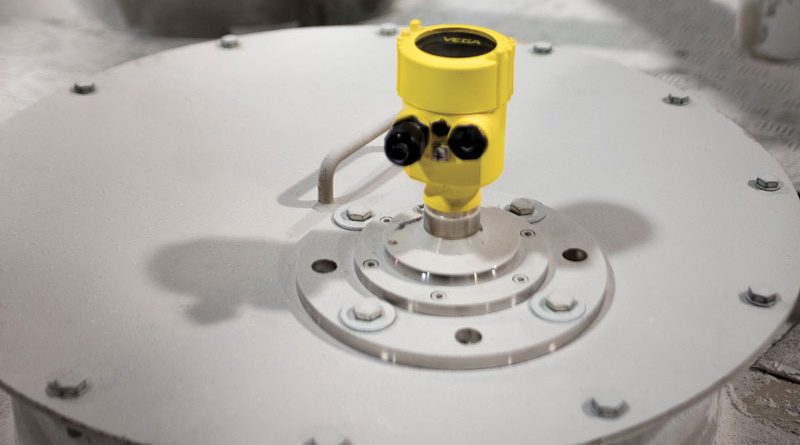Level Sensors: Stocks Are Guaranteed
A company in the Veneto region producing marble and quartz worktops has chosen VEGA radar level sensors. These instruments, which operate under far from simple conditions, ensure sufficient stocks of raw materials at all times
Located in the Valpolicella area, Santamargherita produces marble and quartz surfaces for the kitchen and bathroom. The raw material used is composed of 93% natural quartz. The quartz sands combined with resins and colouring pigments are pressed in a special high-pressure process using vacuum and vibration. Sturdy and resistant to impacts and scratches, the surfaces are produced with grits of different size, consistency and colour. The numerous variants require the storage of a large quantity of raw materials. Santamargherita has several silos for quartz, resin, rinsing water and more. To ensure the supply of raw materials at all times, VEGA sensors are used at various points in the manufacturing process. The application conditions for level measuring instruments are not simple. In addition to vibrations, resin buildup, dirt and dust, explosion protection is also required at certain points. Santamargherita already had positive experiences with VEGA sensors, but not in raw material handling. Since the company had offered to support it for installation in the various applications, the test phase was omitted.

Storage of quartz powder
Quartz powder is stored in cylindrical tanks with a conical lower part. Previously, instruments for 4 … 20 mA base capacitive level measurement by another manufacturer were used. Santamargherita decided to equip three silos with VEGAPULS 69 radar level measuring instruments. They are based on 80 GHz technology and are equipped with an antenna with DN 100 and a swivelling flange. The high frequency ensures reliable measurement of the tank contents with a radar sensor accuracy of ±5 mm. The 80 GHz technology has a small opening angle, so that the measuring range avoids internal installations or buildup on the tank walls. This superior focusing of the transmitted signal offers various advantages. The main one is the better differentiation of the actual measurement signal from interfering signals, and the safe detection of even the smallest reflected signals. The non-contact measuring technology also eliminates the problem of cable wear. The radar sensor VEGAPULS 69 also has a large dynamic range. The dynamics describes the difference between the largest and smallest signal which may be detected by the system. The large dynamic range of 120 dB allows even the smallest reflections to be measured. With a measuring range of up to 120 m, a reaction time of 1 s and an accuracy of ±5 mm, the instrument offers a sufficient performance margin even for unusual applications.

A system automatically signals the supply needs
After the use of VEGAPULS 69 in three silos, Santamargherita intended to gradually replace the capacitive probes of the other silos with this instrument. The next step also began to be considered: in addition to continuous stock detection, this sensor can be integrated into the VEGA Inventory System (VIS). The VIS provides a timely and automatic indication of supply requirements. The software not only uses current stock measurement data, but also empirical data from past consumption. A range of analysis and planning tools enables optimum planning of requirements, inventory and supply. Thanks to bar graphs and tank symbols, current stocks are always under control. While VEGA’s sensors and control units collect all measurement data, the VIS provides a reliable basis for good planning, so that the purchase of raw materials can also be automated.
Are supplies sufficient?
The Santamargherita plant also houses a storage system consisting of several rectangular tanks containing stocks of quartz powder. As this is an automated system, the customer requested a solution which would provide information on the volume of each individual tank. The mechanical level measuring instruments installed did not work with the necessary precision. Even for this application, VEGA offered a solution with VEGAPULS 69 integrated with a VEGADIS 81. This external display and adjustment unit can be mounted up to 50 m away from the sensor in an easily accessible position. The sensor signals are then transmitted to a computer which manages the data. This makes it possible to create a load curve corresponding to the product volume. A test instrument has been installed here too, positioned in various tanks and at different points to collect experiences. As soon as the test will be concluded and the necessary data will have been collected, it is intended to equip all other units with the VEGAPULS solution.

Use in tanks for liquid products
80 GHz radar sensors are also used in tanks containing liquid products. One of them collects the waste water resulting from the calibration and polishing process of the quartz tops, in which foam is present on the surface. Previously an ultrasonic sensor was used in the tank.
The radar level measuring instrument VEGAPULS 64 is also based on 80 GHz technology, but has been optimised for use in liquids. Like its equivalent for bulk solids, it is not affected by environmental conditions. VEGAPULS 64 was also used in a solvent based liquid resin storage tank.
Even in this environment, the VEGA sensor with ATEX approval delivers precise measured values of the level in the steel tank. To determine the minimum and maximum level in tanks containing resin, Santamargherita uses capacitive level sensors of the VEGACAP 64 type for level detection. Critical aspects for the previous sensors were, on the one hand, the quartz dust and carbonate adhering to the resin and, on the other hand, frequent contact problems. This is due to the crystallisation of the resin and the subsequent creation of bridges affecting the sensor output signal. The new VEGACAP sensors, on the other hand, reliably detect the minimum and maximum threshold levels.

